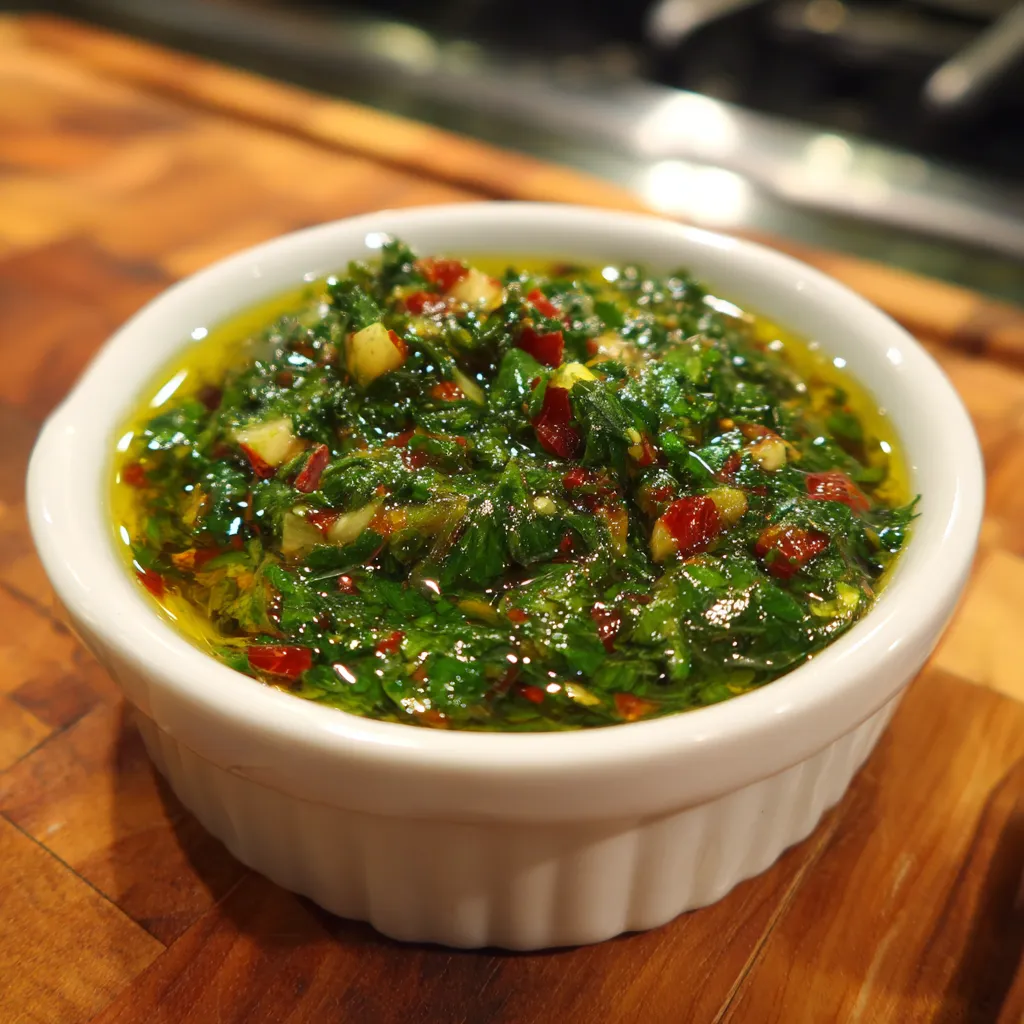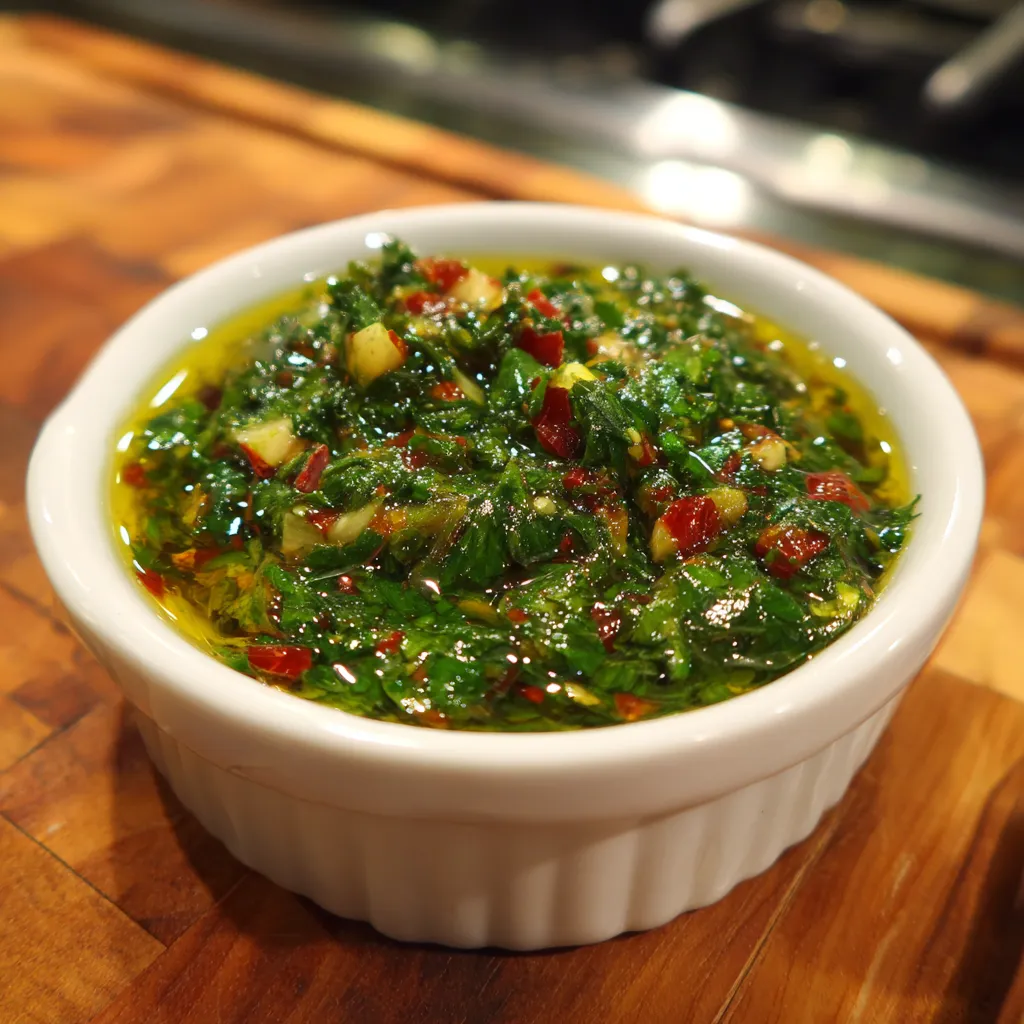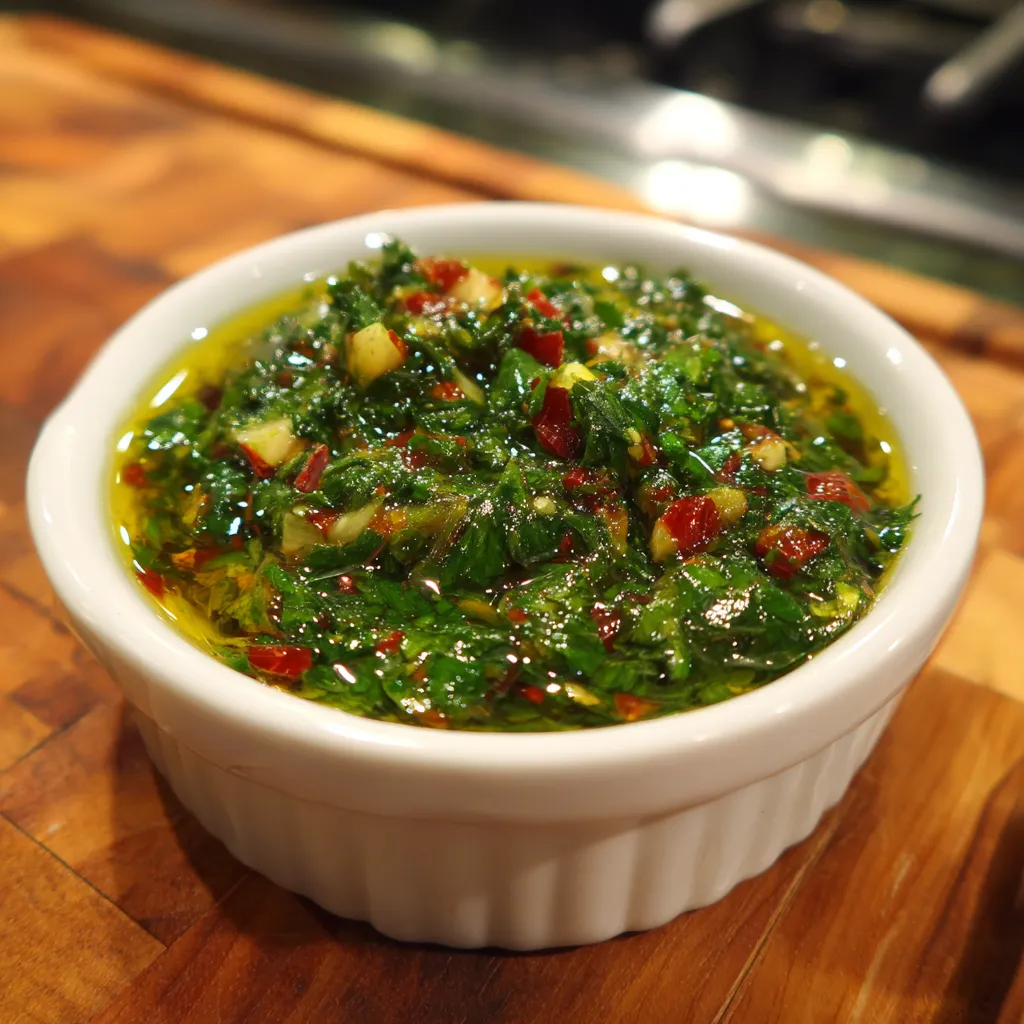 pin it
pin it
I remember the first time I encountered chimichurri - it was love at first taste. The sauce had this incredible freshness that seemed to wake up every taste bud. What struck me immediately was how the parsley didn't just taste like garnish, but was the star of the show, providing this wonderful grassy, clean flavor. The garlic added a sharp bite that played perfectly against the smoothness of the olive oil. That hint of red wine vinegar brought just enough acidity to brighten everything up, while the red pepper flakes gave it a gentle heat that lingered pleasantly. I was amazed that something so simple could be so complex in flavor. The oregano added this earthy, almost floral note that tied everything together. Making it myself, I discovered that the key is not to over-process the herbs - you want some texture, some rustic charm. Each ingredient maintains its identity while contributing to this harmonious whole. It's a sauce that celebrates the beauty of fresh, quality ingredients prepared simply.
Why I love this recipe
What I absolutely adore about this chimichurri recipe is its pure, unadulterated freshness. There's something almost magical about how these simple ingredients transform into something so much greater than the sum of their parts. I love that it requires no cooking - just chopping, mixing, and letting the flavors meld. It's one of those recipes that connects you to the ingredients in the most direct way possible. The vibrant green color never fails to make me smile, and the aroma is intoxicating. I appreciate how versatile it is - whether I'm grilling for a crowd or just want to elevate a simple weeknight dinner, chimichurri delivers every time. There's also something deeply satisfying about the texture - the way the herbs maintain their structure while the oil brings everything together. I love how it improves with time, how the flavors deepen and marry in the refrigerator. Most of all, I love how it makes people happy. I've never served chimichurri without getting compliments and recipe requests. It's become my culinary calling card, and every time I make it, I'm reminded of why I fell in love with cooking in the first place.
What You Need From Your Kitchen
- Fresh flat-leaf parsley: wash, dry thoroughly, and finely chop removing thick stems
- Fresh oregano: remove stems and finely chop the leaves
- Garlic cloves: peel and mince very finely or crush with salt
- Extra virgin olive oil: use high-quality oil for best flavor
- Red wine vinegar: provides acidity and tang to balance the herbs
- Red pepper flakes: adjust amount based on desired heat level
Let's Make These Together
- Prepare Fresh Herbs
- Start by washing your parsley and oregano under cold water, then pat them completely dry with paper towels. Remove any thick stems and finely chop the herbs with a sharp knife. The key is to chop them fine enough to release their oils but not so much that they turn to mush.
- Process Garlic
- Peel your garlic cloves and mince them as finely as possible. For an even smoother texture, try crushing them with a pinch of salt using the flat side of your knife - this creates a paste-like consistency that distributes more evenly throughout the sauce.
- Mix Dry Ingredients
- In your mixing bowl, combine all the chopped herbs, minced garlic, red pepper flakes, and salt. Stir everything together so the flavors start to mingle and the salt begins to draw out the natural oils from the herbs.
- Add Wet Ingredients
- Slowly drizzle in the olive oil while whisking, followed by the red wine vinegar and lemon juice. The mixture should have a slightly chunky consistency with a beautiful green color and a glossy finish from the oil.
- Rest and Adjust
- Let your chimichurri sit at room temperature for at least 20 minutes. This resting time is crucial as it allows all the flavors to marry together. Taste and adjust the seasoning - you might want more salt, acid, or heat depending on your preference.
 pin it
pin it
Switch Things Up
I first discovered chimichurri during a backyard barbecue at my neighbor's house. They had just returned from Buenos Aires and were eager to share their culinary discoveries. As soon as I tasted that first spoonful drizzled over perfectly grilled steak, I knew I had to learn the recipe. The fresh herbs were so vibrant and the garlic had just the right bite. What surprised me most was how easy it was to make - no cooking required! Now I keep a jar in my fridge at all times. Sometimes I add a touch more red pepper flakes when I'm feeling adventurous, or extra lemon juice for brightness. My family has come to expect it at every barbecue, and friends always ask for the recipe. It's become my signature sauce, and I love how it makes even the simplest meals feel special.
Perfect Pairings
Chimichurri is incredibly versatile and pairs beautifully with grilled steaks, especially ribeye or flank steak. It's also fantastic with grilled chicken, lamb chops, or pork tenderloin. For vegetarians, try it drizzled over grilled vegetables like zucchini, bell peppers, or portobello mushrooms. It makes an excellent marinade for shrimp or fish, and I love it as a dip for crusty bread or empanadas. You can even toss it with roasted potatoes or use it as a sandwich spread. The acidic brightness cuts through rich, fatty foods perfectly, making it an ideal complement to cheese boards or charcuterie platters.
 pin it
pin it
Frequently Asked Questions
- → How long does chimichurri last in the refrigerator?
Homemade chimichurri will keep in the refrigerator for up to one week when stored in an airtight container. The flavors actually improve over time as the ingredients meld together.
- → Can I make chimichurri ahead of time?
Yes! Chimichurri is actually better when made at least 2 hours ahead of serving. This allows the flavors to develop and intensify. It's perfect for meal prep and entertaining.
- → Can I freeze chimichurri sauce?
While you can freeze chimichurri for up to 3 months, the texture of the fresh herbs will change once thawed. It's best enjoyed fresh or refrigerated for optimal flavor and consistency.
- → What's the best way to chop the herbs for chimichurri?
Use a sharp knife to finely chop the herbs by hand, or pulse briefly in a food processor. Avoid over-processing as this can make the herbs mushy and affect the texture of your sauce.
- → Can I substitute dried herbs for fresh ones?
Fresh herbs are essential for authentic chimichurri flavor and color. Dried herbs will not provide the same vibrant taste or appearance, so it's best to stick with fresh parsley and oregano.
- → What can I serve with chimichurri besides steak?
Chimichurri is incredibly versatile! Try it with grilled chicken, fish, roasted vegetables, empanadas, crusty bread, or even as a marinade for shrimp or lamb.
Conclusion
This authentic chimichurri sauce brings the bold flavors of Argentina right to your kitchen. With its bright herb taste and perfect balance of garlic and spice, it's the ideal companion for grilled meats and vegetables. The beauty of this recipe lies in its simplicity - just fresh ingredients combined to create something truly spectacular. Once you taste homemade chimichurri, you'll never want to buy store-bought again. It keeps well in the refrigerator and actually improves in flavor as the ingredients meld together.
